Welcome to our guide on How to Tan a Snake Skin. Whether you are an avid wildlife enthusiast or looking for a unique craft project, tanned snake skin can be a great way to preserve these remarkable animals! In this article, we’ll explore how to properly tan a snake skin and answer some of the most frequently asked questions. We will also provide several helpful tips to ensure the best possible result. Let’s get started!
How to Tan a Snake Skin?
Step 1: Tools and Supplies
The first step in tanning a snake skin is to gather the necessary tools and supplies. You will need some form of water-based leather preservative, such as mink oil or neatsfoot oil. Additionally, you will need several large bowls, rubbing alcohol or another disinfectant, salt, and several clean rags. [2]
Step 2: Cutting
Once you have all of your supplies gathered, the next step is to skin the snake. This is a delicate process that should be done carefully. You will need to make sure that you remove as much of the fat and muscle tissue from the skin as possible. Once this is done, you can begin cleaning the skin in a large bowl using rubbing alcohol.
Once the skin is cleaned, you will need to cut it into manageable pieces. This can be done using a sharp knife with a steady hand. Be sure to measure each piece carefully as you cut so that they are all of uniform size and shape for easier tanning later on. [2]
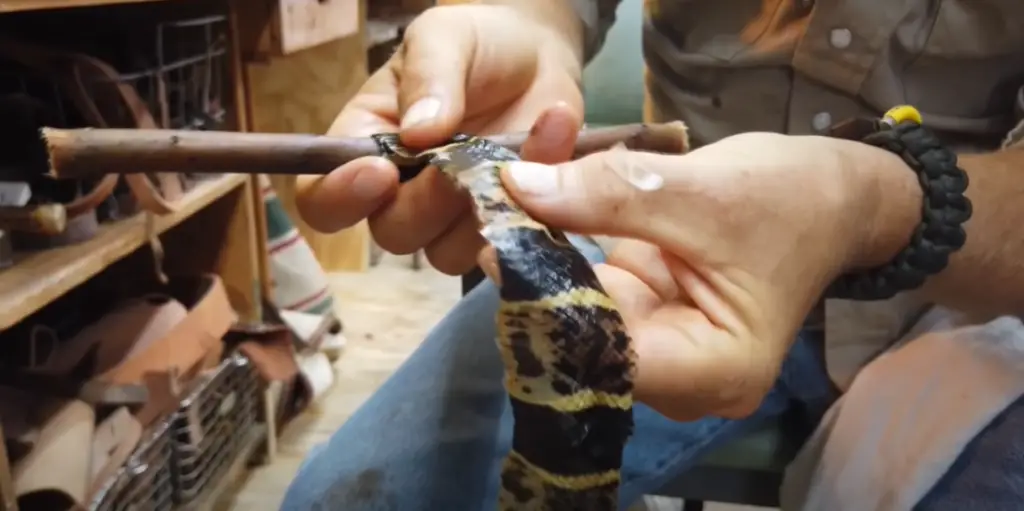
Step 3: Prepping
Once the skin is cut into pieces, it’s time to begin preparing it for tanning. You will need to salt each piece of skin with a generous amount of common table salt. This helps to draw out any remaining fat and moisture that could interfere with the tanning process. You will also need to make sure that no dirt or debris remains on the skin.
After the pieces are salted, you can begin to soak them in a bowl of warm water for at least 24-48 hours. This will further help to draw out any remaining fat and moisture from the skin. You should change the water every 8-12 hours during this process. [2]
Step 4: Pinning
Once the skin has been soaked, it’s time to begin pinning. This is an important step in the tanning process as it helps to keep the skin flat and even during the drying phase. You will need to use several thin pins (such as sewing pins) around the edges of each piece of skin. Make sure that there is at least one pin per inch of skin.
After the pins have been placed, you will need to place each piece of skin on a flat surface and stretch it out as evenly as possible. This is important for achieving an even tan. Once the skins are stretched, you can begin to apply the leather preservative with a clean cloth or sponge. [2]
Step 5: Drying Your Snake
Once the skins have been treated with leather preservative, it’s time to begin drying. You will need to place each piece of skin in a cool, well-ventilated area and allow them to dry completely before proceeding. This could take up to several days depending on how wet the skins were when they began the tanning process. [2]
Step 6: Tanning Solution
When the skins have dried completely, you can begin to apply the tanning solution. This is a mixture of water and tannic acid that will help to preserve the skin and give it its recognizable hue. Be sure to apply two coats of the solution onto each piece of skin and allow them to dry between applications. [2]
Step 7: Pressing It
The last step in tanning a snake skin is to press it. This will help to keep the skin flat and give it its finished appearance. You can use an electric or hand-operated leather press for this step. Be sure to follow all of the manufacturer’s instructions carefully when using either type of press. [2]
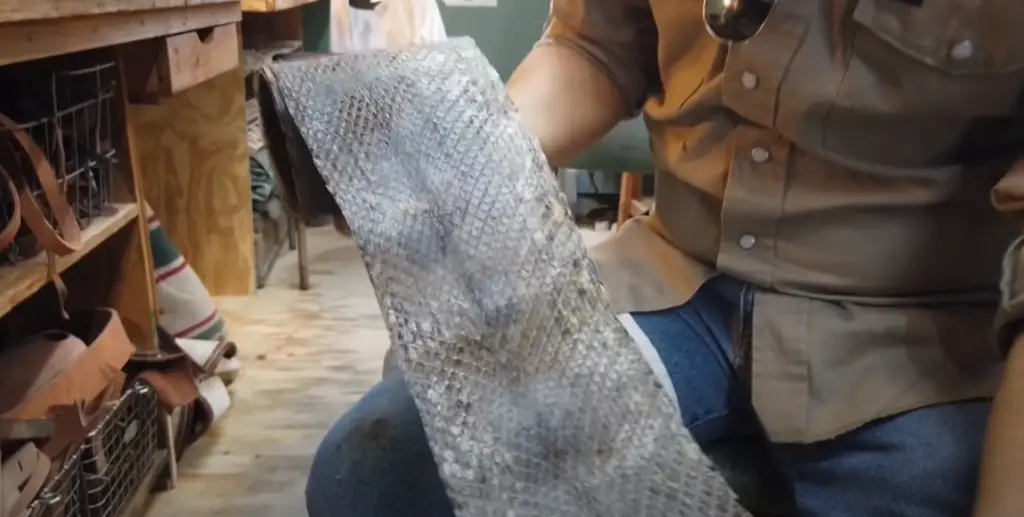
Step 8: Caring for Your Hide
Once the tanning process is complete, you will need to properly care for your newly tanned hide. You can do this by storing it in a cool, dry area and away from direct sunlight. Additionally, you should use leather conditioner on the skin occasionally to help keep it supple and soft. [2]
How to Tan a Skin With Antifreeze?
Antifreeze is a popular and cost-effective option for tanning snake skin. This method requires special equipment and a few days of your time, but the end result will be well worth it! Here’s an overview of how to tan a snake skin with antifreeze:
First, you’ll need to obtain the necessary supplies – such as a large, deep container, gloves, antifreeze, and a soft brush. Once you have all of these items in place, it’s time to start.
Begin by stretching the snake skin onto an appropriate frame. Make sure that the leather is completely dry before proceeding further. Next up, mix equal parts antifreeze and water in your container. Submerge the skin in this liquid and bring it to a slow boil for around 10 minutes – this will kill any bacteria present on the leather and help preserve its structure.
Once the boiling process is complete, remove your snake skin from the antifreeze mixture and give it a good scrubbing with a soft brush. [1]
How to Tan a Snake Skin With Borax?
Tanning a snake skin using borax is an effective and eco-friendly way to preserve the hide. You’ll need some basic supplies such as borax, a large bucket, a plastic container, rubber gloves and safety goggles.
Begin by cleaning the snake skin with warm water and mild soap. This will help remove any dirt and debris. Set the skin aside to dry completely.
Next, mix up a solution of one-third cup of borax with two quarts of warm water in your bucket. Add the snake skin to this solution and let it soak for 24 hours. This will help loosen any oil or fat on the hide and make it easier to tan.
Remove the snake skin from the borax solution and rinse it with warm water.
Now, you’ll need to flesh the hide. This means removing any remaining oil, fat or tissue that may be left on the skin. You can do this with a stiff brush and hot running water. [1]
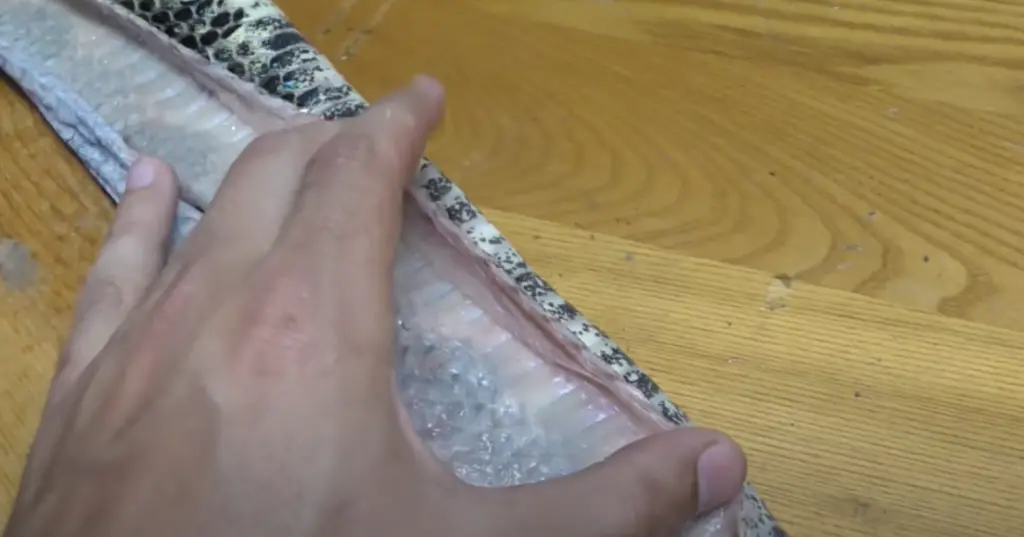
Tanning Snake Skin Without Glycerin
If you do not have access to glycerin or would prefer not to use it, there are other options for tanning snake skin.
Once done, rinse off the excess mixture with warm water and hang your snake skin in a cool place to dry. Once completely dry, the snake skin should be cured and ready to use.
Another option is to use a solution of salt water and sodium bicarbonate or baking soda. The same cleaning process applies as with the above method. Then dissolve 1 part salt to 2 parts baking soda in a gallon of warm water. Place the snake skin in this solution for 3 days before rinsing and hanging it to dry. [1]
How to Tan a Skin With Glycerin?
If you want to preserve a snake skin and make it look attractive and attractive for years to come, then tanning it is your best option. As with any other animal hide, tanning using glycerin makes the material softer and more pliable while also helping to maintain the natural color of the skin. The process of tanning a snake skin is relatively simple and straightforward. Here are the steps:
- Start by thoroughly cleaning your snake skin with a mild soap solution to get rid of any dirt or debris that may have stuck to it during handling or storage. Once the skin is clean, let it dry completely before you begin tanning.
- Soak the skin in a preservative solution such as glycerin for 24 hours. This helps to keep the skin from drying out and prevents it from becoming brittle over time.
- Rinse off the glycerin solution with water and use a soft cloth to remove any excess liquid.
- Hang the snake skin in an airy, dry place until it is completely dry. You can also spread it out on a flat surface and use a fan to speed up the drying process.
- Once dry, brush the skin lightly with a soft bristle brush or an old toothbrush to remove any lingering dirt or debris.
- Rub the dry snake skin with leather oil or beeswax to help keep it flexible and prevent cracking over time. [1]
Tanned Snake Skin for Sale
Once the tanning process is complete, it is possible to purchase tanned snake skin from a variety of sources. Tanned snake skins can be found in leather shops, taxidermy stores and online retailers. These are great options for those not wanting to tackle the process themselves or who need a larger quantity for their project.
When selecting a tanned snake skin for purchase, look for one of high quality. Inspect the snake skin closely to ensure no signs of damage or wear and tear. It is also important to select a snake skin that fits your intended project in terms of size and thickness. Different types of snakes have different sized scales, so make sure you get the right type of snake for whatever you’re making! [1]
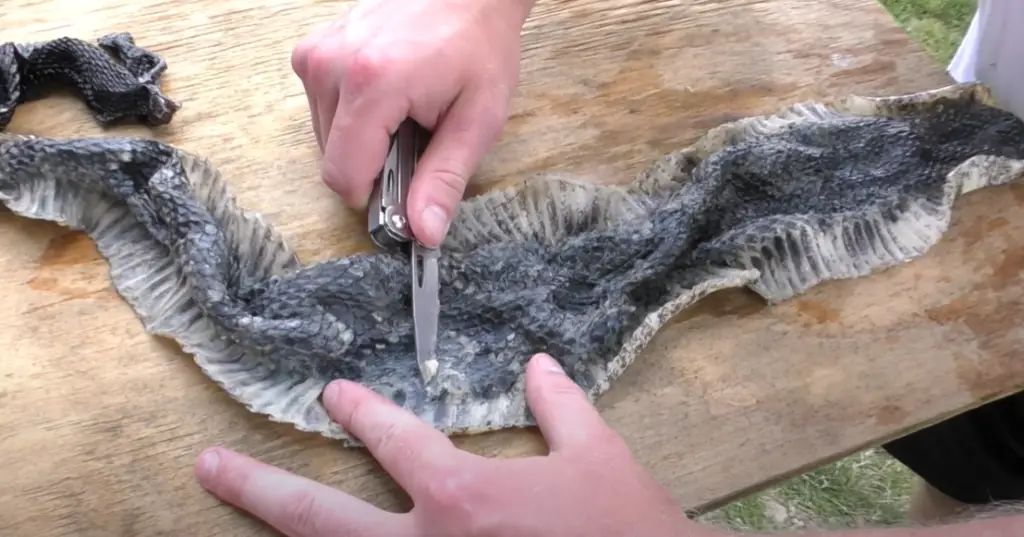
Safety
- When tanning a snake skin, safety must be considered. Here are some important tips:
- Wear protective clothing and gloves when handling the snakeskin and any chemicals used during the tanning process.
- Never use your bare hands to handle the chemical solutions as they can cause irritation and burns.
- Avoid using harsh chemicals or abrasive materials such as steel wool to clean the skin.
- Work in a well ventilated area and always wear a respirator or face mask while tanning.
- Make sure that all containers used for storing the chemical solutions are labeled clearly and kept out of reach of children.
- Dispose of any leftover chemicals safely according to local regulations. [1]
Tips
- Always wear protective gear when handling snakes or snake skins. This includes gloves, long sleeves, and eye protection.
- Start by cleaning the skin in warm soapy water and gently scrubbing it with an old toothbrush until clean. Then rinse it off and dry with a towel. Make sure not to leave any soap residue on the skin.
- If you are tanning the snake in its entirety, stuff it with cotton batting before taping or stitching up the edges. This will give it a more even shape and help to keep it from shrinking too much during the tanning process.
- Once ready, submerge the skin in a solution of salt and alum for 4-5 days. This will help to preserve the collagen and make it easier to work with.
- After the tanning process is complete, rinse off any excess salt or alum from the skin and hang it up to dry. Once dry, you can apply a coat of wax such as beeswax or synthetic leather dressing to protect the skin and give it a shiny finish.
- You can also dye the skin with natural dyes such as tea, coffee, or vegetable dyes. This will give the skin an attractive color and help to prevent it from sun fading over time.
- When displaying your finished snake skin make sure to store it in a cool, dry place out of direct sunlight. [1]
FAQ
Can you tan snake skin with salt?
Yes! Salt is an important part of the tanning process. It helps preserve the skin, prevents it from rotting and also serves as an insect repellent. Before you can begin tanning a snake skin with salt, make sure to thoroughly clean it with soap and water. After that, soak it in a mixture of salt and water for at least 24 hours before moving on to the tanning process.
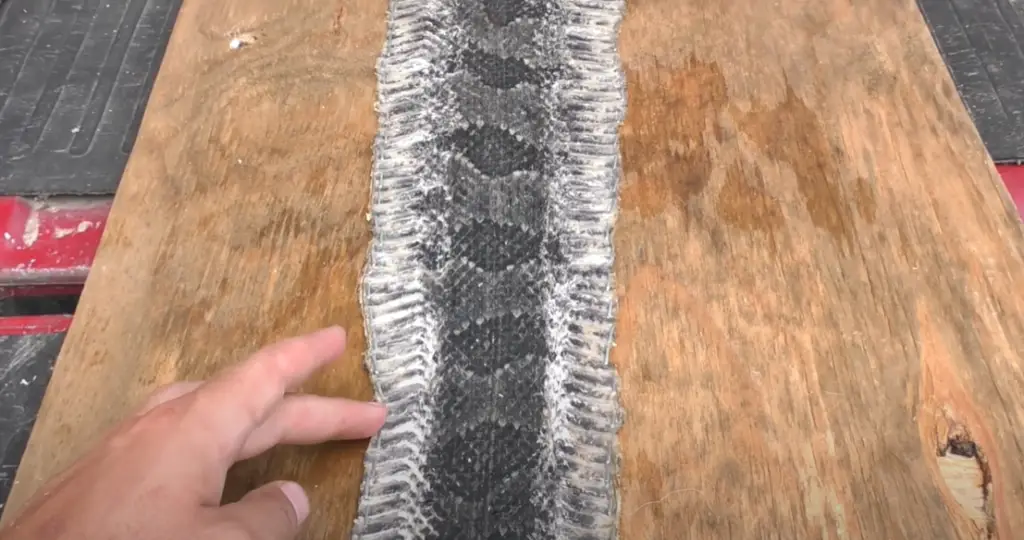
Can you tan snake skin without glycerin?
Yes, you can tan snake skin without glycerin. However, the process will take longer and it won’t be as soft or supple as it would be if glycerin were used. Glycerin helps to lubricate the skin while tanning which makes it softer and more pliable after the process is complete.
What is a homemade snake tanning solution?
A homemade tanning solution can be made by mixing equal parts of rubbing alcohol, hydrogen peroxide, and warm water. This mixture should then be added to a container containing more warm water and salt until it reaches the desired consistency. You can then soak the snake skin in this solution for 12-24 hours before proceeding with the tanning process.
What can I use to tan rattlesnake skin?
Rattlesnake skin can be tanned using the same process as other snake skins. After thoroughly cleaning it, you can soak it in a mixture of salt and water for at least 24 hours before beginning the tanning process. You’ll then need to apply a tanning solution (such as rubbing alcohol, hydrogen peroxide, and warm water) to the skin and let it sit for 12-24 hours. Finally, you’ll need to rub the skin with a leather conditioner or wax to help preserve it.
How do you tan snake skin naturally?
Tanning snake skin naturally involves using natural ingredients such as alum, vinegar, and egg whites. To begin, mix equal parts of alum and vinegar in a container of warm water. Soak the snake skin in this solution for 12-24 hours before proceeding with the tanning process. Afterwards, beat an egg white until it is frothy and apply it to the skin before drying it in the sun. Finally, you’ll need to apply a leather conditioner or wax to help preserve it.
What can I use to tan animal skin?
You can use a variety of methods to tan animal skin, such as natural or chemical tanning processes. For natural tanning, you can use ingredients like alum, vinegar, and egg whites. For chemical tanning, you’ll need a tanning solution containing rubbing alcohol, hydrogen peroxide, and warm water. Finally, you’ll need to rub the skin with a leather conditioner or wax to help preserve it.
Can Vaseline be used for tanning?
Yes, Vaseline can be used for tanning. However, it should only be used after the skin has been tanned and dried. Applying a thin layer of Vaseline to the skin will help protect the tan from dirt and other contaminants. It is important to note that Vaseline should never be used during the actual tanning process as it could damage the skin.
What oils can tan?
Different kinds of oils can be used to tan animal skins, such as olive oil, neatsfoot oil, and lanolin. These oils help lubricate the skin while tanning which makes it softer and more pliable after the process is complete. Additionally, they also act as a natural preservative to help protect the skin from dirt and contaminants.
What oil tans skin?
There are a variety of oils that can be used to tan skin, such as olive oil, neatsfoot oil, and lanolin. Olive oil helps to lubricate the skin while tanning which makes it softer and more pliable after the process is complete. Neatsfoot oil acts as a natural preservative to help protect the skin from dirt and contaminants. Lastly, lanolin helps to seal the pores of the skin and keep it supple and flexible.
Useful Video: Snake Skin Tanning and Preserving -How To –
Conclusion
Tanning a snake skin can be a rewarding experience. It’s not always an easy process, but the results are worth it. With some patience and attention to detail, you can create a beautiful tan that will last for many years.
You’ll need to prepare the skin properly before tanning it, especially if it has been stored for a long time. Be sure to thoroughly clean the skin and remove as much fat, oil, and membrane as possible. Then you can use a commercial tanning product or make your own solution at home.
As with any animal hide, it’s important to take care of snake skins properly after they are tanned. Store them in a cool, dry place away from direct sunlight. Regularly apply a leather conditioner or oil to keep the skin flexible and prevent it from cracking.
Whether you’re tanning a snake skin for personal use, or selling it to another reptile enthusiast, proper care can help ensure that your beautiful work will last for years to come. With these tips in mind, you’ll be ready to get started on your next tanning project! Good luck!
Happy tanning!
References:
- https://zekebloggingadventures.com/how-to-tan-a-rattlesnake-skin-with-antifreeze/
- https://www.instructables.com/Tanning-Rattlesnake-Hide/

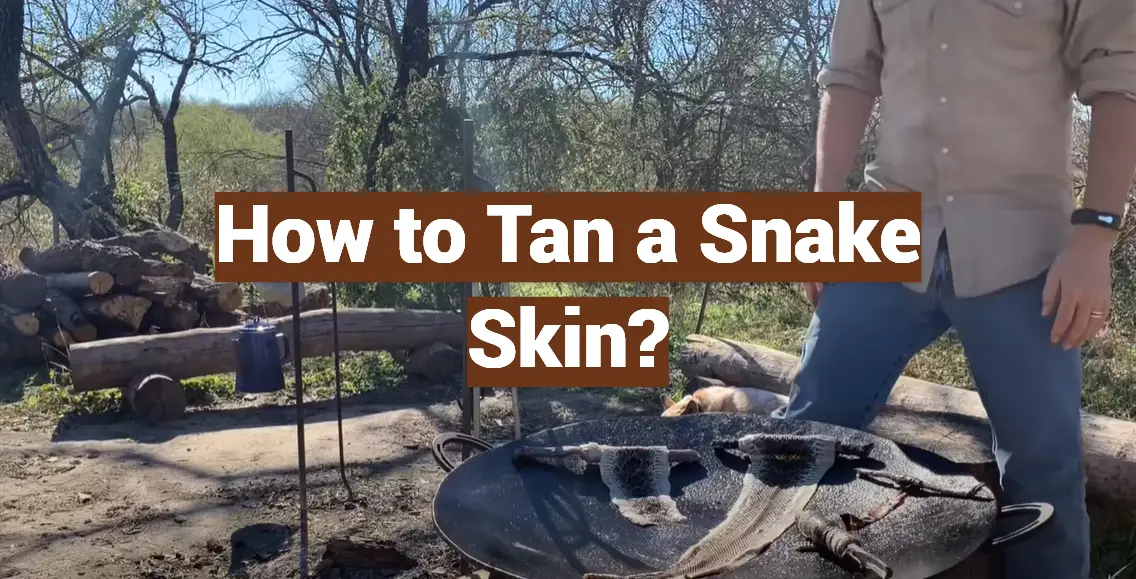



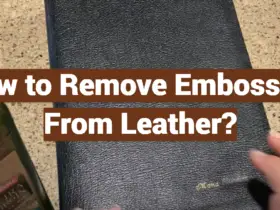

Leave a Reply